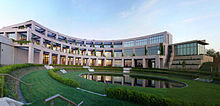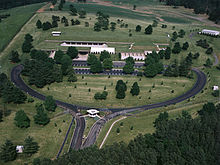- National Audio-Visual Conservation Center
-
The National Audiovisual Conservation Center, also known as the Packard Campus for Audio-Visual Conservation, is the Library of Congress's new audiovisual archive located inside Mount Pony in Culpeper, Virginia. From 1969 to 1988, the facility was a high-security storage facility operated by the Federal Reserve Board. With the approval of the United States Congress in 1997, it was purchased by the David and Lucile Packard Foundation from the Federal Reserve Bank of Richmond via a $5.5 million grant, done on behalf of the Library of Congress. With a further $150 million from the Packard Humanities Institute and $82.1 million from Congress, the facility was transformed into the National Audio-Visual Conservation Center, which completed construction in mid-2007, and after transfer of the bulk of archives, opened for scheduled tours and visitors in fall 2008. The campus offered, for the first time, a single site to store all 6.3 million pieces of the library's movie, television, and sound collection.[1]
Technically, the Packard Campus (PCAVC) is just the largest part of the whole National Audio-Visual Conservation Center (NAVCC), which also consists of the Library of Congress's Motion Picture and Television Division and Recorded Sound Division reference centers on Capitol Hill, the Mary Pickford Theater, and any other Library of Congress audio-visual storage facilities that remain outside the Packard Campus.
The PCAVC design, named Best of 2007 by Mid-Atlantic Construction Magazine,[2] involved upgrading the existing bunker and creating an entirely new, below-ground entry building that also includes a large screening room, office space and research facilities. Designers BAR Architects, project-architect SmithGroup and landscape designers SWA Group, along with DPR Construction, Inc., collaborated in what is now the largest green-roofed commercial facility in the eastern United States, blending into the surrounding environment and ecosystem.[3]
Contents
Federal Reserve Bunker
With Cold War tensions came fear that in the event of a nuclear war, the economy of the United States would be destroyed. In response to this, the United States Federal Reserve constructed a bunker to house enough U.S. currency to replenish the cash supply east of the Mississippi River in the event of a catastrophic event.[4]
Dedicated on December 10, 1969, the 400-foot-long (120 m), 140,000-square-foot (13,000 m2) radiation-hardened facility was constructed of steel-reinforced concrete one foot (30.5 centimeters) thick. Lead-lined shutters could be dropped to shield the windows of the semi-recessed facility, which is covered by 2 to 4 feet (0.61 to 1.2 m) of dirt and surrounded by barbed-wire fences and a guard post. The seven computers at the facility, operated by the Federal Reserve Bank of Richmond, were the central node for all American electronic funds transfer activities.[4]
Between 1969 and 1988, the bunker stored several billion dollars worth of U.S. currency, including a large number of $2 bills shrink-wrapped and stacked on pallets 9 feet (2.7 meters) high. Following a nuclear attack, this money was to be used to replenish currency supplies east of the Mississippi River.[4]
Prior to July 1992, the bunker also served as a continuity of government facility. With a peacetime staff of 100, the site was designed to support an emergency staff of 540 for 30 days, but only 200 beds were provided in the men's and women's dormitories (to be shared on a "hot-bunk" basis by the staff working around the clock). A pre-planned menu of freeze-dried foods for the first 30 days of occupation was stored on site; private wells would provide uncontaminated water following an attack. Other noteworthy features of the facility were a cold storage area for maintaining bodies unable to be promptly buried (due to high radiation levels outside), an incinerator, indoor pistol range, and a helicopter landing pad.[4]
The facility also housed the Culpeper Switch, which was the central switching station of the Federal Reserve's Fedwire electronic funds transfer system, which at the time connected only the Fed's member banks. The Culpeper Switch also served as a data backup point for member banks east of the Mississippi River.[4]
Post Cold War
In 1988, all money was removed from Mount Pony. The Culpeper Switch ceased operation in 1992, its functions having been decentralized to three smaller sites. In addition, its status continuity of government site was removed. The facility was poorly maintained by a skeleton staff until 1997 when the bunker was put up for sale. With the approval of the United States Congress, it was purchased by the David and Lucile Packard Foundation from the Federal Reserve Bank of Richmond via a $5.5 million dollar grant, done on behalf of the Library of Congress. With a further $150 million from the Packard Humanities Institute and $82.1 million from Congress, the facility was transformed into the National Audio-Visual Conservation Center, which opened in mid-2007. The center offered, for the first time, a single site to store all 6.3 million pieces of the library's movie, television, and sound collection.
Campus Architecture
The Packard Campus was designed to be a green building, being situated mostly underground and topped with sod roofs. It was designed to have minimal visual impact on the Virginia countryside by blending into the existing landscape. From the northwest, only a semi-circular terraced arcade appears in the hill to allow natural light into the administrative and work areas. Additionally, the site also included the largest private sector re-forestation effort on the Eastern Seaboard, amassing over 9,000 tree saplings and nearly 200,000 other plantings.[5]
The underground vaults (some set to temperatures below freezing) contain nearly 90 miles (140 km) of shelving, not including 124 nitrate film vaults:[6] the largest nitrate film storage complex in the Western hemisphere. The campus's data center is the first archive to preserve digital content at the petabyte (1 million gigabyte) level.[5]
Of special interest is the 206-seat theater capable of projecting both film and modern digital cinema and which features a digital organ rising from under the stage to accompany silent film screenings.[5] The Packard Campus currently holds semi-weekly screenings of films of cultural significance in its reproduction Art Deco theater according to this schedule.
References
- ^ "Library of Congress Unlocks the Ultimate Archive System". http://magazine.creativecow.net/article/the-library-of-congress-unlocks-the-ultimate-archive-system.
- ^ "Mid-Atlantic Construction Magazine Best of 2007". http://midatlantic.construction.com/projects/MA_BestOf2007.pdf.
- ^ "Features of Packard Campus". http://www.loc.gov/avconservation/packard/features.html.
- ^ a b c d e McCamley, N.J. Cold War Secret Nuclear Bunkers. Pen & Sword Books Ltd, 2002.
- ^ a b c "Packard Campus Architecture". http://www.capitol.gov/html/VGN_2010061458862.html.
- ^ "Architect of the Capitol (AOC)". http://www.aoc.gov/cc/LOC.cfm.
- "Mount Pony" (HTML). 1998-04-29. http://www.fas.org/nuke/guide/usa/c3i/mt_pony.htm. Retrieved 2007-01-01.
- "The Fed's Own Cold War Bunker" (HTML). Archived from the original on 2007-09-27. http://web.archive.org/web/20070927122913/http://www.gatewayva.com/biz/virginiabusiness/magazine/yr2003/feb03/fedside.shtml. Retrieved 2007-03-29.
- "The Culpeper Switch (Federal Reserve Booklet)" (HTML). http://coldwar-c4i.net/Mt_Pony/culpsw01.htm. Retrieved 2007-03-29.
Further reading
- McCamley, N.J. Cold War Secret Nuclear Bunkers. Pen & Sword Books Ltd, 2002. ISBN 0-85052-746-5
External links
- The Federal Reserve's Communications and Records Center (Culpeper, Virginia)
- Federation of American Scientists
- National Audio Visual Conservation Center (NAVCC) home page
- "Welcome to the Time Capsule," Michael Gaynor, Washingtonian magazine, April, 2011
- "Mountain Archive Home to Bogart, Beiber" Associated Press, March 2011
- "Culpeper Film Vault Offers Glimpse Into American History" Newsplex.com February 2011
- "Digitizing the Past and the Present at the Library of Congress," boingboing June 9, 2010
- "Library of Congress Unlocks the Ultimate Archive System," Creative Cow Magazine May 2010
- "LOC Facility Copes with Plethora of Formats," GovernmentVideo February 2010
- "A New Home for History," GovernmentVideo Dec 2009
- "Preservation Before Recreation," Allison Brophy Champion, Culpeper Star-Exponent, March 22, 2009
- "Welcome to an AV Mecca," Pro AV, March 2009
- "A/V Heritage in the Country but not out to Pasture," Barbara Hesselgrave, May 13, 2008
- "Projecting the Future Needs of Preservation," Washington Post, March 30, 2008
- "World's Largest Audio-Visual Archive," Kevin Kelly March 29, 2008
- "Digitizing History, Government Video March 2008
- "Culpeper's Treasures," NBC-29 Charlottesville, VA February 4, 2008
- "Print Tramps to New Home," Hollywood Reporter, January 16, 2008
- "The New National Audiovisual Conservation Center," Audiophile Audition, December 18, 2007
- "National Audio-Visual Conservation Center," The Picture Show Man, October 2007
- "Library of Congress Readies New Digital Archive," Internetnews.com, October 10, 2007
- "Mid-Atlantic Construction magazine announces Best of 2007 Winners, Library of Congress National Audio-Visual Conservation Center honored as overall best project," October 9, 2007
- "Library of Congress Gives Hillside Bunker a New Use," AIArchitect, September 28, 2007
- "Gift Helps Center Preserve Film, Audio Recordings," San Jose Mercury News, September 10, 2007
- "Magical Mystery Tour," Culpeper Star Exponent, September 9, 2007
- "Cinema Saver: Dave Packard of Stanford Theatre gives millions to national film-preservation effort," MetroActive, September 5-11, 2007
- "Archivists Have Place of Their Own to Save Past," The Hollywood Reporter, September 5, 2007 and "Reuters (shorter version of article)"
- "Library's Preservation Team Settles Into New Home," Roll Call, September 4, 2007
- "Cold War Bunker Now Shelters Archive," Los Angeles Times, August 31, 2007
- "Casablanca Joins Kinescopes at Former Fed Bunker in Virginia," Bloomberg News, August 29, 2007
- "Library Gets Gift of Space," Variety, August 24, 2007
- "Library of Congress Adds Audio-Visual Campus," National Public Radio, August 23, 2007
- "Packard Makes Donation to Library of Congress," Palo Alto Online, August 6, 2007
- "Dr. Strangelove Finds Home in Washington," Business Week (via Architectural Record), August 6, 2007 and "Additional Photos," Architectural Record, August 1, 2007
- "Buried Treasures" Washington Times article, August 4, 2007
- "A Remarkable Gift," Library of Congress Information Bulletin, July/August 2007
- "Library of Congress Gets Packard Campus for Audio-Visual Conservation," Radio World, July 27, 2007
- "Packard heir gives audio-visual facility to Library of Congress," Washington Post article, July 27, 2007
- "Library of Congress Has New Archive," Government Computer News, July 26, 2007
- "Library Accepts Historic Gift," July 26, 2007 News Release
- "New Digs for Old Treasures," Government Computer News, July 16, 2007
- Planning for Digital Preservation and Acquisitions at the Library of Congress National Audio-Visual Conservation Center, May 2007
- "Mystery on Mt. Pony," Culpeper Star Exponent, March 25, 2007
- "The National Audio-Visual Conservation Center," Mike Mashon, Cinema Journal, Spring 2007
- "LOC at Mt. Pony Opens in April," Culpeper Star Exponent, October 21, 2006
- Film & Sound Treasures In the Mountain Lair," Helen Dalrymple, LC Information Bulletin, July/August 2006
- "Constellation of Cultural Input," Culpeper Star Exponent, March 26, 2006
- "Culpeper Center will be Movie-Lovers Dream," Associated Press via WTOP newsradio, March 31, 2005
- "Bunker Holds a Mountain of Movies," Wired, May 5, 2004
- "The Vault/How the studios stopped worrying and learned to love the bomb factory," Brooks Boliek, The Hollywood Reporter, June 13, 2000
- "$10 million Packard Grant Funds AV Center," Library of Congress Information Bulletin, July 1998
- "U.S. defrosts film, TV archive/Library of Congress may get hands on former Cold War vault," Brooks Boliek, The Hollywood Reporter, November 14, 1997
Categories:- Archives in the United States
- Cold War
- Disaster preparedness in the United States
- Federal Reserve
- Library of Congress
- Nuclear bunkers
Wikimedia Foundation. 2010.



